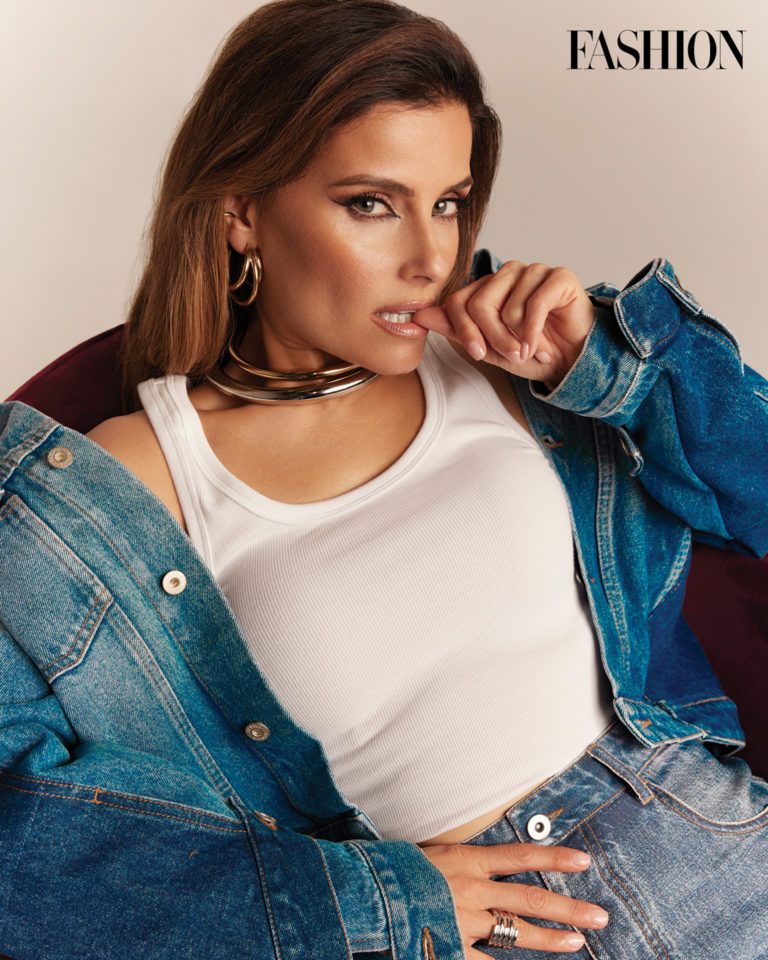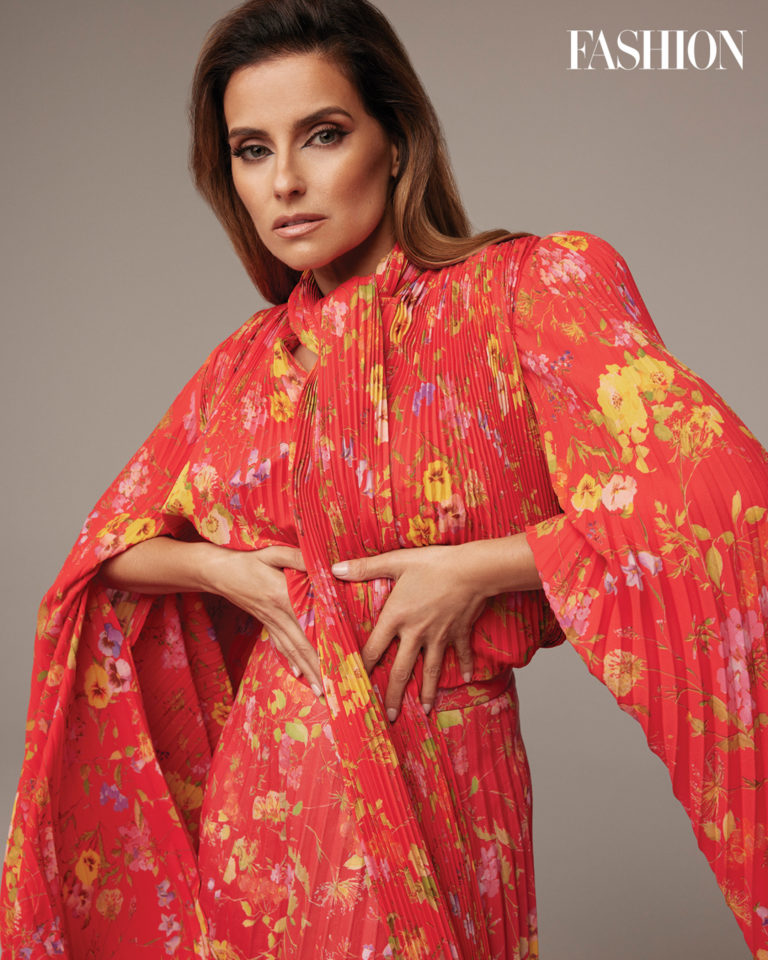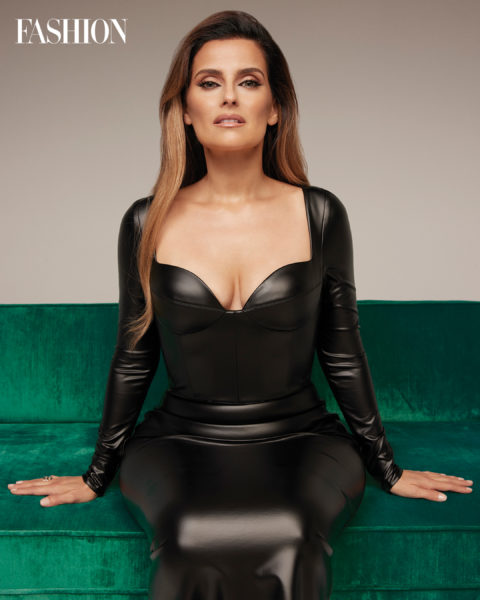Like many of us, Nelly Furtado took a much-needed break from social media. Unlike many of us, she took a break that lasted five years — from 2017 to about a year ago, when she not only returned to social media but leaned into it with the force of a Ferrari.
It was her daughter Nevis, now 20, who reignited her interest after showing her that her 2006 hit “Promiscuous” was trending on TikTok. “I was like, ‘What does that mean — that it’s trending?’” Furtado laughs at her obliviousness. Now, of course, she gets it and delivers amusing BTS and dance videos and admits that she gets as sucked into doomscrolling as the rest of us. But most important to her is that social platforms are a source of creative inspo — whether it’s through sharing playlists with friends or listening to remixes that DJs DM her on Instagram. “I love this direct contact with other artists and musicians,” she says. “There is this constant conversation going on.”

Blazer, $1,865, and pants, $1,420, Dion Lee. Shoes, $1,195, Christian Louboutin. Ring, price upon request, Jennifer Fisher.
Furtado is speaking from her office in Toronto and, in true Canadian style, is deeply apologetic about calling late. (She was having trouble with the lock on the door.) She is days away from the release of “Keep Going Up,” which she describes as “a big musical hug” with previous collaborators Timbaland and Justin Timberlake. Their first recording together was the 2007 electro hit “Give It to Me,” which has been given new life in remixes by Gen Z fans. She connected with Timbaland early this summer to mark the 17th anniversary of her album Loose. “I think we were both shocked that this music we made in Miami many years ago is resonating with people so much lately,” she says. Other early Furtado hits have also been reimagined by total strangers, with one track alone — “Say It Right” x Bicep’s “Glue” — getting seven million streams.
“When you’re young and you put an album out, you’re thinking ‘Maybe this is a fluke or maybe people just like this now and they won’t like it later,’” Furtado remarks. “But 20 years in, people of all ages are still loving these songs. I’ve realized the strength of my catalogue and my music. It’s given me a lot of confidence.”
And it’s not just the past that’s resonating. Furtado’s first release in five years, “Eat Your Man,” with Australian record producer Dom Dolla, was one of the hottest singles of the summer. She slayed at Lollapalooza and Osheaga this season and grabbed headlines in September after presenting an award to Taylor Swift at the MTV Video Music Awards while wearing a backless Dundas dress that dipped down over her cheeks.
I’VE REALIZED THE STRENGTH OF MY CATALOGUE AND MY MUSIC. IT’S GIVEN ME A LOT OF CONFIDENCE.
Most women get more modest, not less, as they age — especially 44-year-old mothers of three. (Furtado also has a four-year-old son and a five-year-old daughter.) “When I first started, I was trying to preserve my identity as an artist,” Furtado explains. Her hip-hop/electronic aesthetic translated to baggy jeans, sneakers, hoop earrings and Princess Leia buns. “Every photo shoot I went to those first couple of years, I would bring a bag with all my raver clothes inside,” she recalls. “If things weren’t going well, I would abort the mission and put on a comfy outfit. I wasn’t yet comfortable trying on different looks. Now I love walking in and saying to the stylist ‘Dress me up like a doll.’”
Her own stylist, Toronto-based Marc Andrew Smith, has been turning up the heat with body-con dresses and unitards by Ottolinger, Syndical Chamber and Toronto’s Susan Dicks. Off-duty, Furtado dresses for how she feels in the moment and recently told Vogue that her go-to brands include Off-White, Marine Serre, Dion Lee, Mugler and Jean Paul Gaultier as well as Bottega Veneta and Amina Muaddi for shoes. “And I have a new trick,” she adds. “I make sure I love all the pieces in my closet and then I don’t decide what I’m going to wear until five minutes before I get dressed. If I plan my outfit, I’ll inevitably change my mind because my mood changes. I’m very spontaneous.”
Some of that spontaneity might be due to ADHD, which Furtado was diagnosed with about two years ago. While there are some downsides (“we’re kind of messy”), she has learned to accentuate the positive. “In the studio in particular, it’s become a superpower,” she shares. “My mind is very fast — often 20 steps ahead. I feed off the energy, and that way I can be working on more than one song at once.” She describes recording vocals for one piece and then in between takes starting a new song, which her crew writes down. “That’s something I’ve always done, but now I might have two rooms going, with producers in one room and me in the other, and I go back and forth; the creativity keeps bubbling, and I can ride that wave really well. I don’t get overwhelmed at all. I love it.” The expressiveness of Furtado’s voice, even over the phone, is obvious. Her sentences rise and fall like she is practising scales. She drops into a moody, reflective range when she is pondering a question and then soars into a childlike squeal when she thinks of an amusing answer. It’s so clear that as an artist, she is expert at conveying emotion through not only one word but also one syllable — even if that syllable is “um.”

Jacket, $2,500, Loewe. Top, $20, Aritzia. Pants, $2,050, Bottega Veneta at Holt Renfrew. Earcuff, $275 for three, earring, $820 for a pair, necklace (top), $550, and necklace (bottom) and ring, prices upon request, Jennifer Fisher.

Blouse, $6,150, and skirt, $8,650, Balenciaga.
Musicality is in her DNA. “My mother’s father was a brilliant composer and multi-instrumentalist and the conductor of his local marching band,” she says, explaining that her family were “creative, wildly brilliant, musically gifted farmers and builders” in the Azores. “When my mother was growing up, women weren’t allowed to be in the band.” So when Furtado was young, her mom put her in the marching band at their church in Victoria, B.C. “She was so proud of me,” she says. Furtado played her trombone six days a week, and though her grandfather died when she was nine, she says she got to meet him on a visit to São Miguel, see his stash of handwritten compositions and hold his old clarinet. “I do approach music with this legacy mindset,” she says. “That’s where I got the gift from, and I’m super grateful for it.”
Furtado attributes her ability to withstand the pressures of early fame to her grounding in family. She worked as a chambermaid with her mom and didn’t explode onto the scene until after graduating from high school. “I got to go to prom and backpack in Europe — those little things made a really big difference,” she says. She also had a strong instinct for when to take a time out. “I knew when to remove myself from the spotlight, put on some sunglasses and a ball cap and disappear into the crowd when it became too overwhelming.”
Still, when Nevis was young, Furtado famously cried her way through a few songs during a performance in Amsterdam. But she used the experience as an exercise in self-awareness. “I can’t be out there burning both ends of the candle or I get burned out really quickly,” she acknowledges. With two more children now, Furtado is definitely pacing herself. She is more realistic about scheduling and carving out time for self-care, which includes candlelit baths, picnicking in the park with her little ones and listening to music. “I’m very spoiled because Dom Dolla sends me whole sets that he would play for a crowd and that you can’t get anywhere,” she says. “His fans would be so jealous. And Questlove sends me his amazing playlists once a month — hopefully he won’t stop sending them to me when I say this!” The Latin-heavy lineup she played at the FASHION cover shoot was compiled by Colombian-Canadian singer Lido Pimienta, one of Furtado’s closest friends.

Dress, $875, Lamarque. Shoes, $3,275, Christian Louboutin.

Dress, $9,250, Hermès. Bracelet, $9,350, Van Cleef & Arpels.
She is also making some time for dating, which she says is “really fun.” “Because I’ve never known myself as well as I do now, and I’m not chasing anything,” she explains. “Plus, there’s nothing I care more about than my kids and my work. So it puts dating into perspective, right?”
Work is also fun, she says, because of the confidence she has now compared to her early years. “I had some really big moments as my first introduction to this business — my first photo shoot was with Vanity Fair!” she says with a how-wild-is-that laugh. “And then one of my first TV performances was on Saturday Night Live. I was this very nervous gangly 21-year-old tomboy going ‘Whoa! What’s going on?’” She also learned to deal with the surprises that come with performing live. “I tripped on my guitar player’s amp and went tumbling into the audience at the Hard Rock Cafe in New Orleans,” she recalls. “I literally had a chain-link-shaped bruise on my back.”
Thankfully, most of her performances go much better than that, including her comeback moment in 2022 at Drake’s OVO Fest after a five-year absence from the stage. She shocked the crowd by stepping out and singing “I’m Like a Bird” with the rapper, who told the audience he’d had a tough time convincing her to appear. But the experience seemed to reignite something in Furtado; her seventh studio album is currently in the works.
“Now I realize that I’m really doing it for me,” she shares. “I’m doing it for the craft. I’m doing it because I’m competing with myself. I want to be my best at every element of my career, whether it’s recording or performing or photo shoots. I’m a perfectionist. So I know there’s always another level to attain.” She’s worked on the very high choruses of “Promiscuous” and feels she is singing them better than she ever did. And she spends hours in the dance studio, which she says really helps with her ADHD. “I did about three and a half hours of really intense choreography for a show, and then I came home and was able to organize my whole closet,” she explains. “When doing choreography, your brain and your body have to be in sync, and that discipline is really effective.”
Most of all, she’s enjoying the experience of connecting with her audiences again. She says she sometimes feels like she’s in a giant karaoke where everybody’s just having a great time and so is she. And unlike some artists who moan about having to play old hits over and over, she says she never tires of delivering “I’m Like a Bird” live. “I would never be the type of person to say ‘I’m over that song’ because I’m not. I think: ‘Isn’t this a blessing? That’s so amazing that all these people know this song.’” Maybe that’s why Furtado, like the lyrics say, may fly away for a while now and then, but she’ll never fade.
1/3
2/3
3/3



